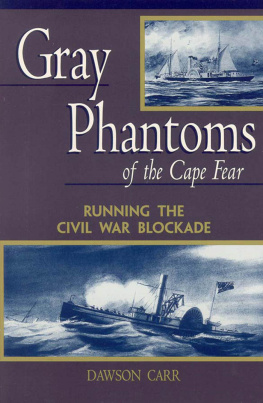
ALSO BY DAWSON CARR
The Cape Hatteras Lighthouse: Sentinel of the Shoals

Copyright 1998 by John F. Blair, Publisher
All rights reserved
Printed in the United States of America
Front cover photos:
Top: The Ella and Annie.
Bottom: The Eolus captures the blockade runner Lady Sterling as she attempts to leave Wilmington.
(Both photos courtesy of U. S. Naval Historical Center)
Design by Liza Langrall
The paper in this book meets the guidelines
for permanence and durability of the
Committee on Production Guidelines for
Book Longevity of the Council on Library Resources.
Library of Congress Cataloging-in-Publication Data:
Carr, Dawson.
Gray phantoms of the Cape Fear : running the
Civil War blockade / Dawson Carr.
p. cm.
Includes bibliographical references and index.
ISBN 0-89587-213-7 (alk. paper)
I. BlockadeNorth CarolinaCape Fear RiverHistory19th century. 2. Cape Fear River (NC)History, Naval19th century. 3. Wilmington (N.C.)History19th century. 4. North CarolinaHistoryCivil War, 18611865Naval operations. 5. United StatesHistoryCivil War, 18611865Naval operations. I. Title.
F262.C2C37 1998
973.730975627dc2I 98-21315
To my parents,
Leo Dawson Carr and Carita Home Carr
CONTENTS
A BOOK IS almost never written single-handedly. Dozens of people contribute to bringing a story into print, and I want to thank those who gave generously of their time and knowledge to help me.
First of all, I thank the staff of the Sandhills Community College Library. Their help in obtaining rare books and manuscripts through the interlibrary-loan system was invaluable. I especially appreciate the patience and able assistance of Joy Mercer, who labored faithfully to help me find necessary sources and never chided me when I needed the material longer than expected.
Beverly Tetterton and Joe Shepard of the North Carolina Collection at the New Hanover County Library in Wilmington made my research productive and enjoyable. Their bookshelves and file cabinets hold a rich store of North Carolina history, especially of Wilmington and the coastal region.
John M. Coski and Terri Hudgins of the Museum of the Confederacy in Richmond, Virginia, provided photos of blockade runners and helped me locate rare copies of cargo lists for ships that docked at Wilmington during the Civil War.
Richard Lawrence, Mark Wilde-Ramsing, and Barbara Brooks of the Office of State Underwater Archaeology, North Carolina Division of Archives and History, took time from their busy schedules to help me locate details of the designs of blockade runners and their engines.
Connie Mason of the North Carolina Maritime Museum in Beaufort and Mary Strickland of the Southport Maritime Museum provided contacts for obtaining information on Cape Fear River pilots. Mary treated me to a view of rare, original copies of John Maffitts charts of the Cape Fear region, drawn when he was a United States naval officer stationed there before the Civil War.
Gehrig Spencer, site specialist at Fort Fisher, generously stayed after working hours to share his knowledge of the fort and the battle to capture it. His descriptions of the locations and armaments of the other fortresses built near Cape Fear during the war provided details that would have been difficult to find elsewhere.
The Duke University Special Collections Library provided me considerable information; Elizabeth Dunn, womens studies reference archivist, was instrumental in helping me obtain facts on Rose ONeal Greenhow.
The North Carolina Collection and the Southern Historical Collection, both housed in the Wilson Library at the University of North Carolina, are excellent sources of historical information on North Carolina and the Civil War. The staffs there were very helpful to me.
The staff of the North Carolina Division of Archives and History provided access to maps from the Civil War years and to the letters of Governor Vance from the same period.
I am indebted to Wesley Loy, who allowed me to draw information from his treatise, 10 Rumford Place: Doing Confederate Business in Liverpool, which he wrote following a visit to England while a student at the University of Mississippi.
A special note of thanks goes to Robert and Elsie Aycock, who allowed me to use an excerpt from one of the letters in their privately published book, The Civil War Letters of W. D. Carr of Duplin County, North Carolina.
I appreciate the help given me by the staffs of the Library of Congress and the Naval Historical Foundation in my quest for appropriate illustrations to include in the book. I especially thank E. C. Finney, Jr., and Janice Smith of the Naval Historical Foundation.
I had the honor of interviewing descendants of two of the Smithville-based Civil War pilots. Joseph Joe Sam Loughlin and his wife, Eleanor, allowed me into their Southport home to hear stories from their familys history. John Julius Swain and his wife, Pauline, also of Southport, shared their family background with me as well. Joe Sam is a descendant of Thomas Washington Brinkman, pilot of the Condor, and John is the great-grandson of John Julius Dosher, pilot of the North Heath.
I needed help to decipher the mysteries of computers. Diane Innes of the Computer Engineering Department at Sandhills Community College helped set up my computer for word processing, and Shari Smith of the colleges Writing Center patiently tutored me on the commands and capabilities of the program. My son Larry helped me out of many computer tangles and listened faithfully, often into the wee hours, as I tried to explain by phone the problems I had created.
Stephen Smith, professor of English at Sandhills Community College and columnist for the Southern Pines newspaper, The Pilot, gave me advice when I first became interested in writing this book. He later loaned me a laptop computer for use at various libraries, saving me many hours of scratching out notes on three-by-five cards.
I thank my friend Wayne Burris for reading the early draft of the manuscript and for his perceptive suggestions.
I am indebted to the staff of John F. Blair, Publisher, for without their help, there would be no book. I owe a debt of gratitude to Andrew Waters, who read my sample chapter and outline. I also appreciate the work of Liza Langrall, who fashioned the cover and handled the layout and design work, and Anne Holcomb and Molly Yarbrough for their help in publicity and sales. Most of all, I thank Carolyn Sakowski, who gave me a contract, and Steve Kirk, who worked diligently to help me put the rough manuscript into better form and proper order.
Lastly, I thank my wife, Bobbi, who encouraged me when I was down and understood when my writing prevented me from assuming my full share of the responsibilities of home and family.

THE MOST DEADLY war in United States history continues to fascinate readers and scholars almost a century and a half after it ended. Perhaps no story among the countless episodes of heroism, suffering, and sacrifice by both sides during the Civil War is more amazing than the contest that evolved between the ships of the United States Navy and the blockade runners that sought to deliver cotton to Europe and bring armaments and supplies to the Confederacy in return.
Next page















